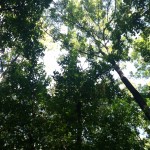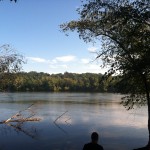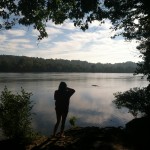It was the way the light hit the trees that really got to me. Something in the way the leaves were moving and the way the fog was dancing on the water. Everything seemed entirely independent of my presence. It was like it had it’s own life and its own heartbeat. And as nestled as it was in the suburbs, the wetlands seemed miles away from anything remotely human.
Naturally, this impression of separation is completely false. We parked outside near a trail and we were surrounded by houses, and even closer by was the main road that led back to campus. But as we were walking, I couldn’t help but notice how serene it all was. How quiet it seemed. How the grass just grew where it pleased and how the roots of trees crisscrossed and overlapped each other as if playing a game. With each step that I took, I felt a little more distant from my everyday life.
I remember, as silly as it sounds, when I was little (and even a bit now), obsessing over the screensaver of my computer. I know this seems like a pretty far leap from the James, but give me a second to explain. Generally, computers come with tons of images pre-uploaded to use as the background, or in my case, the screensaver and it becomes pretty clear pretty quickly that companies hire photographers to go out into nature and take photographs of sweeping and breathtaking landscapes. Sometimes these images are even artificial. Regardless of how they are produced, it was always hard for me to accept that maybe the creek near my house wasn’t going to produce exactly the same reaction as what the photographers for Apple had captured on the beaches of Hawaii or of the fields in Iceland. I can remember some really golden moments in my life when I could just stand in absolute awe of what I was looking at, but unfortunately, those moments are rare. I went to Canada in middle school and for part of my vacation, I was at an extremely secluded lake with a friend. There was a forest that had been torn apart by a storm in such a way that it looked like a claw from “War of the Worlds” had passed through and I remember just how the trees looked and the immense walls of sand to this day. A couple of years ago I went out to Palo Alto in California and saw Redwood forests for the first time. Those, to me, were screen saver moments.
But those places had something going for them before I even arrived. They not only looked like the images I had already seen and understood as beautiful or moving, but they were also in places that were pretty well known for having nature that supposed to be beautiful or moving. I came into the situation with the idea that those forests or that lake had to be something that I could have a sublime experience with and I would be lying if I said that that fact didn’t have some sort of influence over my reaction.
I am from an area of Maryland where the Potomac river is pretty close by, so I’ve lived my entire life in a community that tries to teach people about the river (and in a broader sense, the Chesapeake Bay) in order to protect it and cherish it as an thing we can coexist with and not just live near. I can’t count how many of those “screensaver images” I’ve seen in calendar or postcard form of the Bay, as if convincing people that if the area was more beautiful than other areas, it made it more worth protecting or just getting involved in.
So here is what really hit me about the wetlands in the James River: nature doesn’t need to be justified. We shouldn’t have to convince anyone that only the places that produce sweeping views in a photograph are important or beautiful. People pay thousands of dollars to go on vacations to stand in the awe of mountains and valleys, which is completely fine, but a lot of the time, those very same people can’t seem to see the beauty of their local river or forest. And only until very recently can I say I started to appreciate that. When we visited the wetlands, we came across a clearing that I simply stood and stared at, and wanted to go run though it because it seemed so untouched and so beautiful. And yes, it did look like a screensaver. But I got to see that in my backyard. I didn’t really need to go that far out of my way to see something that took my breath away.
I’m sure the people that are in charge of protecting the James all sat down in a room one day and decided to take pictures of it from the best angle with the best sunlight and the most flowers to put on their website or on a postcard hoping those images would inspire people to protect the river. And why not? It’s a pretty smart move after all-they know that that’s what people want to see. Either they’ll show a beautiful picture of the river and ask people to keep it beautiful or a grotesque picture of the river full of trash to scare people into cleaning it up. But that last option would be a little depressing and I sincerely doubt many people are going to try to market something as unsexy as cleaning a dirty river with even dirtier pictures. What I can’t understand now is why there isn’t more emphasis on the everyday beauty of the things that are around us. We need to move past this idea that only huge majestic things are worth being in awe of and wanting to preserve because those small things only add to the big ones. We are in an age where we are simply too aware of how connected everything is in nature to just ignore things because they aren’t featured as your computer’s background. As a cell must be healthy to sustain an organism, the each river and forest must be healthy to sustain the earth.
I would have never known about that little valley if I hadn’t gone there with our class, but I’m really glad I did. By the end of this, I don’t see why my view of the James can’t be up there with that lake in Canada or the forests in California. It truly deserves to be.



